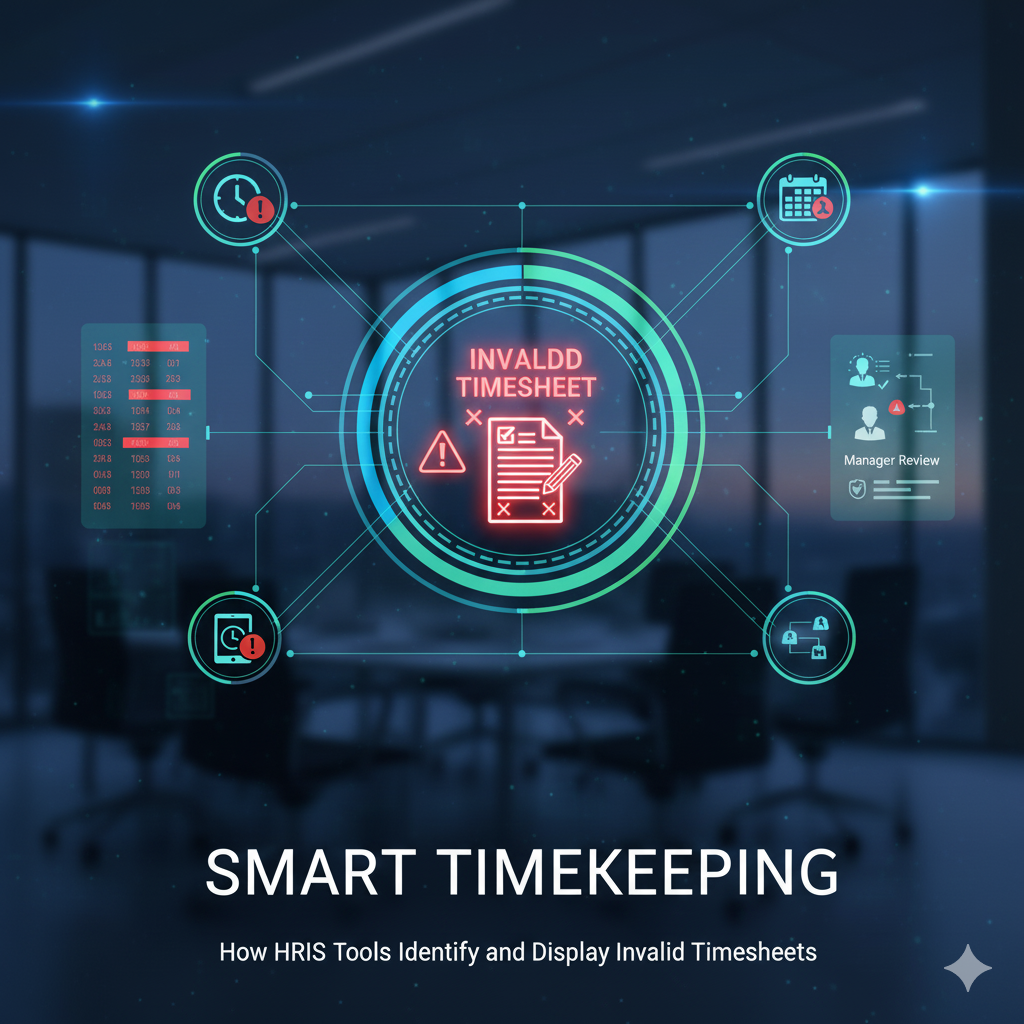Address
Kaypian, San Jose Del Monte City, Bulacan Philippines
Work Hours
Monday to Friday: 8AM - 6PM
Weekend: 10AM - 5PM
Address
Kaypian, San Jose Del Monte City, Bulacan Philippines
Work Hours
Monday to Friday: 8AM - 6PM
Weekend: 10AM - 5PM


Integrated HR. Accurate Payroll.


Integrated HR. Accurate Payroll.

Timekeeping is the backbone of accurate payroll and efficient HR management. But what happens when errors sneak into employee timesheets — missing clock-ins, overlapping shifts, or incomplete data?
In traditional systems, these errors often go unnoticed until payroll discrepancies appear. This can lead to incorrect payments, compliance issues, and wasted HR time.
That’s why modern HRIS (Human Resource Information System) solutions include smart timekeeping tools designed to identify and display invalid timesheets automatically, ensuring accuracy before payroll processing begins.
Let’s explore how this feature works and why it’s transforming the way HR teams manage attendance.
An invalid timesheet is any time record that contains incomplete, inconsistent, or incorrect data. Common examples include:
❌ Missing clock-in or clock-out entries
❌ Overlapping time logs (e.g., two shifts on the same day)
❌ Unapproved leave or attendance on a rest day without authorization
❌ Incorrect day types, such as work hours logged on declared holidays
❌ Out-of-range timestamps, like logging in before a shift officially starts
These errors not only delay payroll but can also affect attendance reporting, overtime computation, and compliance tracking.
In many organizations, HR staff must manually review each timesheet to catch errors — a time-consuming and error-prone process, especially in large companies.
Manual validation often results in:
⚠️ Missed errors due to human oversight
🕒 Delayed payroll runs caused by rechecking attendance data
💸 Incorrect pay computation when errors go unnoticed
📋 Audit risks from inaccurate time records
To address this, smart HRIS timekeeping tools automate the process — identifying invalid entries instantly and showing HR teams where to take action.
Modern HRIS platforms include built-in validation logic that scans time logs for inconsistencies and flags potential issues automatically.
Here’s how they work:
✅ 1. Automatic Data Validation
The system continuously reviews each employee’s time logs against configured rules — such as shift schedules, holidays, and attendance policies. Any irregularity triggers an “invalid” status.
✅ 2. Real-Time Error Flagging
As soon as an invalid entry is detected, it’s highlighted in the dashboard or marked with warning indicators (e.g., red icons, color codes). This allows HR staff to spot issues instantly.
✅ 3. “Invalid List” Display Panel
The HRIS system automatically compiles a list of invalid timesheets, showing details like:
✅ 4. Validation by Branch or Department
Multi-branch organizations can filter invalid timesheets by branch, department, or date range, helping local HR teams resolve issues efficiently.
✅ 5. Integration with Attendance Devices
The HRIS syncs with biometric scanners or online time logs, cross-checking entries to ensure data completeness and accuracy.
Once invalid entries are displayed, HR personnel or managers can take corrective action directly from the HRIS interface.
The system typically allows users to:
🖊️ Edit or update missing clock-ins/outs
📆 Adjust incorrect schedules or day types
✅ Revalidate corrected timesheets instantly
🔄 Sync updated data with payroll automatically
Each correction is logged in the audit trail — recording who made the change, when, and why — maintaining full data transparency and compliance.
💡 1. Improved Payroll Accuracy
By detecting invalid timesheets early, HRIS systems prevent payroll errors before they happen — ensuring correct pay for every employee.
💡 2. Time Savings for HR Teams
Automatic validation reduces the manual workload of checking timesheets, allowing HR staff to focus on strategic tasks.
💡 3. Compliance and Audit Readiness
Every invalid entry and correction is tracked in the system, making audits and labor inspections more straightforward.
💡 4. Employee Transparency
Employees can be notified of invalid entries in their self-service portals, promoting accountability and proactive correction.
💡 5. Reduced Payroll Delays
Fewer invalid timesheets mean faster data approval, ensuring timely and accurate payroll releases.
Imagine your company has 500 employees across multiple branches. Before payroll cutoff, the HRIS automatically generates an “Invalid Timesheet List” that highlights 10 employees with missing time-outs.
This automation ensures payroll remains accurate, consistent, and stress-free — even at scale.
In today’s hybrid and fast-moving work environments, attendance data flows in from multiple devices and locations.
Without smart validation tools, HR teams risk losing control over timekeeping accuracy.
By using HRIS systems that display invalid timesheets, organizations gain:
It’s the perfect combination of automation, accuracy, and accountability.
Invalid timesheets can disrupt payroll, cause compliance headaches, and damage employee trust — but they don’t have to.
With smart HRIS timekeeping tools, you can automatically identify, display, and correct invalid timesheets before they affect payroll.
This not only ensures accurate records but also saves HR teams hours of manual work while maintaining transparency and control.
If your organization still relies on manual validation or post-payroll corrections, it’s time to upgrade to a modern HRIS system that does the heavy lifting for you — so your team can focus on people, not paperwork.